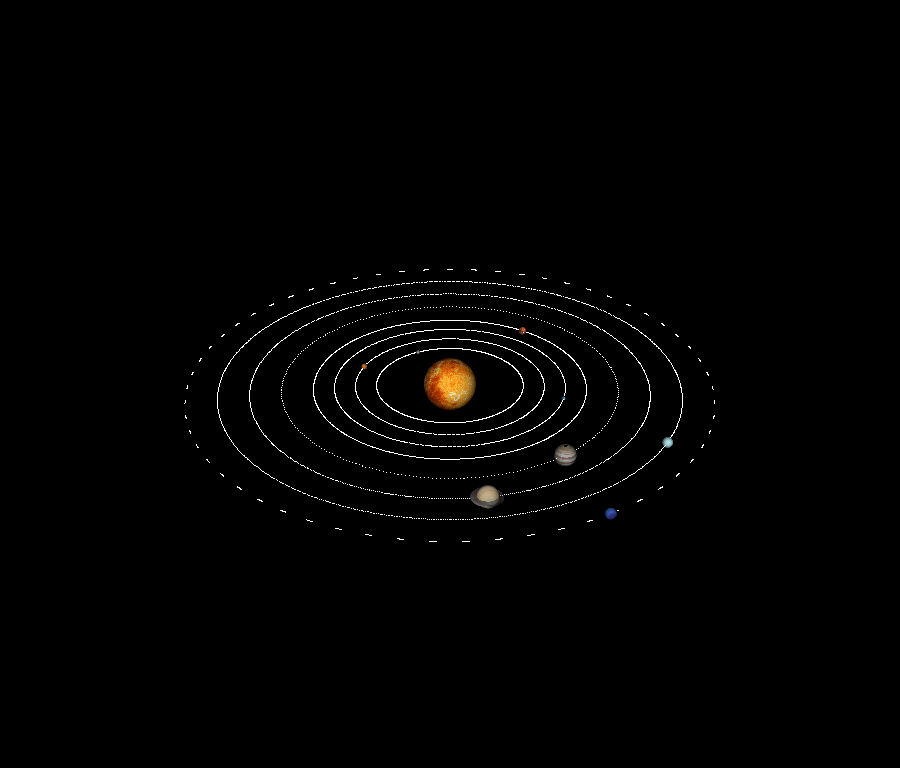Note
Click here to download the full example code
Solar System Animation¶
In this tutorial, we will create an animation of the solar system using textured spheres. We will also show how to manipulate the position of these sphere actors in a timer_callback function to simulate orbital motion.
import numpy as np
from fury import window, actor, utils, io
import itertools
from fury.data import read_viz_textures, fetch_viz_textures
Create a scene to start.
scene = window.Scene()
Load in a texture for each of the actors. To do this, we will create
a function called init_planet, which will initialize each planet actor
given its corresponding filename and actor name. It will also add each
actor to the scene that has already been created.
planet_filenames = ["8k_mercury.jpg", "8k_venus_surface.jpg",
"1_earth_8k.jpg", "8k_mars.jpg", "jupiter.jpg",
"8k_saturn.jpg", "8k_saturn_ring_alpha.png",
"2k_uranus.jpg", "2k_neptune.jpg",
"8k_sun.jpg"]
fetch_viz_textures()
def init_planet(filename):
"""Initialize a planet actor.
Parameters
----------
filename : str
The filename for the corresponding planet texture.
Returns
-------
planet_actor: actor
The corresponding sphere actor with texture applied.
"""
planet_file = read_viz_textures(filename)
planet_image = io.load_image(planet_file)
planet_actor = actor.texture_on_sphere(planet_image)
scene.add(planet_actor)
return planet_actor
Out:
Dataset is already in place. If you want to fetch it again please first remove the folder /Users/koudoro/.fury/textures
Use the map function to create actors for each of the texture files
in the planet_files list. Then, assign each actor to its corresponding
actor in the list.
planet_actor_list = list(map(init_planet, planet_filenames))
mercury_actor = planet_actor_list[0]
venus_actor = planet_actor_list[1]
earth_actor = planet_actor_list[2]
mars_actor = planet_actor_list[3]
jupiter_actor = planet_actor_list[4]
saturn_actor = planet_actor_list[5]
saturn_rings_actor = planet_actor_list[6]
uranus_actor = planet_actor_list[7]
neptune_actor = planet_actor_list[8]
sun_actor = planet_actor_list[9]
# Rotate this actor to correctly orient the texture
utils.rotate(jupiter_actor, (90, 1, 0, 0))
Next, change the positions and scales of the planets according to their position and size within the solar system (relatively). For the purpose of this tutorial, planet sizes and positions will not be completely accurate.
sun_actor.SetScale(5, 5, 5)
mercury_actor.SetScale(0.4, 0.4, 0.4)
venus_actor.SetScale(0.6, 0.6, 0.6)
earth_actor.SetScale(0.4, 0.4, 0.4)
mars_actor.SetScale(0.8, 0.8, 0.8)
jupiter_actor.SetScale(2, 2, 2)
saturn_actor.SetScale(2, 2, 2)
saturn_rings_actor.SetScale(3, 0.5, 3)
uranus_actor.SetScale(1, 1, 1)
neptune_actor.SetScale(1, 1, 1)
mercury_actor.SetPosition(7, 0, 0)
venus_actor.SetPosition(9, 0, 0)
earth_actor.SetPosition(11, 0, 0)
mars_actor.SetPosition(13, 0, 0)
jupiter_actor.SetPosition(16, 0, 0)
saturn_actor.SetPosition(19, 0, 0)
saturn_rings_actor.SetPosition(19, 0, 0)
uranus_actor.SetPosition(22, 0, 0)
neptune_actor.SetPosition(25, 0, 0)
Define the gravitational constant G, the orbital radii of each of the planets, and the central mass of the sun. The gravity and mass will be used to calculate the orbital position, so multiply these two together to create a new constant, which we will call miu.
Let’s define two functions that will help us calculate the position of each
planet as it orbits around the sun: get_orbit_period and
get_orbital_position, using the constant miu and the orbital radii
of each planet.
Let’s change the camera position to visualize the planets better.
scene.set_camera(position=(-20, 60, 100))
Next, create a ShowManager object. The ShowManager class is the interface between the scene, the window and the interactor.
showm = window.ShowManager(scene,
size=(900, 768), reset_camera=False,
order_transparent=True)
Next, let’s focus on creating the animation.
We can determine the duration of animation with using the counter.
Use itertools to avoid global variables.
counter = itertools.count()
To track and visualize the orbital paths of the planets, we will create
several new variables to map each planet’s orbits using actor.dots.
It is important to define the track variable for each planet as global,
allowing it to be used within the timer_callback function. To do this,
create a function called get_orbit_actor.
def get_orbit_actor(orbit_points):
orbit_actor = actor.dots(orbit_points, color=(1, 1, 1),
opacity=1, dot_size=1)
return orbit_actor
All of the planets will have the same initial positions, so assign each of
those to the positions variables for each planet. These variables will be
updated within the timer_callback function. Initialize and add the
orbit actors into the scene. Also initialize the track variables for each
planet.
orbit_points = np.zeros((1000, 3), dtype='f8')
mercury_orbit_actor = get_orbit_actor(orbit_points)
scene.add(mercury_orbit_actor)
positions_mercury = utils.vertices_from_actor(mercury_orbit_actor)
venus_orbit_actor = get_orbit_actor(orbit_points)
scene.add(venus_orbit_actor)
positions_venus = utils.vertices_from_actor(venus_orbit_actor)
earth_orbit_actor = get_orbit_actor(orbit_points)
scene.add(earth_orbit_actor)
positions_earth = utils.vertices_from_actor(earth_orbit_actor)
mars_orbit_actor = get_orbit_actor(orbit_points)
scene.add(mars_orbit_actor)
positions_mars = utils.vertices_from_actor(mars_orbit_actor)
jupiter_orbit_actor = get_orbit_actor(orbit_points)
scene.add(jupiter_orbit_actor)
positions_jupiter = utils.vertices_from_actor(jupiter_orbit_actor)
saturn_orbit_actor = get_orbit_actor(orbit_points)
scene.add(saturn_orbit_actor)
positions_saturn = utils.vertices_from_actor(saturn_orbit_actor)
uranus_orbit_actor = get_orbit_actor(orbit_points)
scene.add(uranus_orbit_actor)
positions_uranus = utils.vertices_from_actor(uranus_orbit_actor)
neptune_orbit_actor = get_orbit_actor(orbit_points)
scene.add(neptune_orbit_actor)
positions_neptune = utils.vertices_from_actor(neptune_orbit_actor)
mercury_track = []
venus_track = []
earth_track = []
mars_track = []
jupiter_track = []
saturn_track = []
uranus_track = []
neptune_track = []
Define two new functions to use in timer_callback to update the planet
positions and their tracks to visualize their orbit: update_track and
update_planet_position.
def update_planet_position(r_planet, planet_actor, planet_track, cnt):
pos_planet = get_orbital_position(r_planet, cnt)
planet_actor.SetPosition(pos_planet[0], 0, pos_planet[1])
planet_track.append([pos_planet[0], 0, pos_planet[1]])
return pos_planet
def update_track(positions_planet, planet_track, planet_orbit_actor):
positions_planet[:] = np.array(planet_track)
utils.update_actor(planet_orbit_actor)
Define the timer_callback function, which controls what events happen
at certain times, using the counter. Redefine the position of each planet
actor using get_orbital_position, assigning the x and y values of
each planet’s position with the newly calculated ones. Append each new
planet position to its corresponding track array.
def timer_callback(_obj, _event):
cnt = next(counter)
showm.render()
global mercury_track, venus_track, earth_track, mars_track, jupiter_track
global saturn_track, uranus_track, neptune_track
update_planet_position(r_mercury, mercury_actor, mercury_track, cnt)
update_planet_position(r_venus, venus_actor, venus_track, cnt)
update_planet_position(r_earth, earth_actor, earth_track, cnt)
update_planet_position(r_mars, mars_actor, mars_track, cnt)
update_planet_position(r_jupiter, jupiter_actor, jupiter_track, cnt)
pos_saturn = update_planet_position(r_saturn, saturn_actor, saturn_track,
cnt)
saturn_rings_actor.SetPosition(pos_saturn[0], 0, pos_saturn[1])
update_planet_position(r_uranus, uranus_actor, uranus_track, cnt)
update_planet_position(r_neptune, neptune_actor, neptune_track, cnt)
if cnt == 999:
update_track(positions_mercury, mercury_track, mercury_orbit_actor)
update_track(positions_venus, venus_track, venus_orbit_actor)
update_track(positions_earth, earth_track, earth_orbit_actor)
update_track(positions_mars, mars_track, mars_orbit_actor)
update_track(positions_jupiter, jupiter_track, jupiter_orbit_actor)
update_track(positions_saturn, saturn_track, saturn_orbit_actor)
update_track(positions_uranus, uranus_track, uranus_orbit_actor)
update_track(positions_neptune, neptune_track, neptune_orbit_actor)
if cnt == 1500:
showm.exit()
Watch the planets orbit the sun in your new animation!
showm.initialize()
showm.add_timer_callback(True, 5, timer_callback)
showm.start()
window.record(showm.scene, size=(900, 768),
out_path="viz_solar_system_animation.png")

Total running time of the script: ( 0 minutes 16.799 seconds)